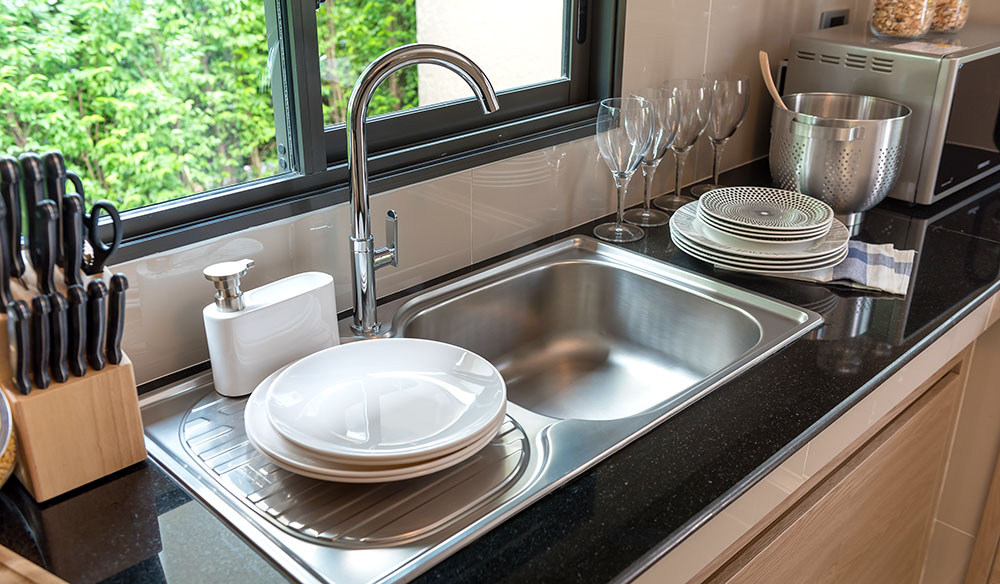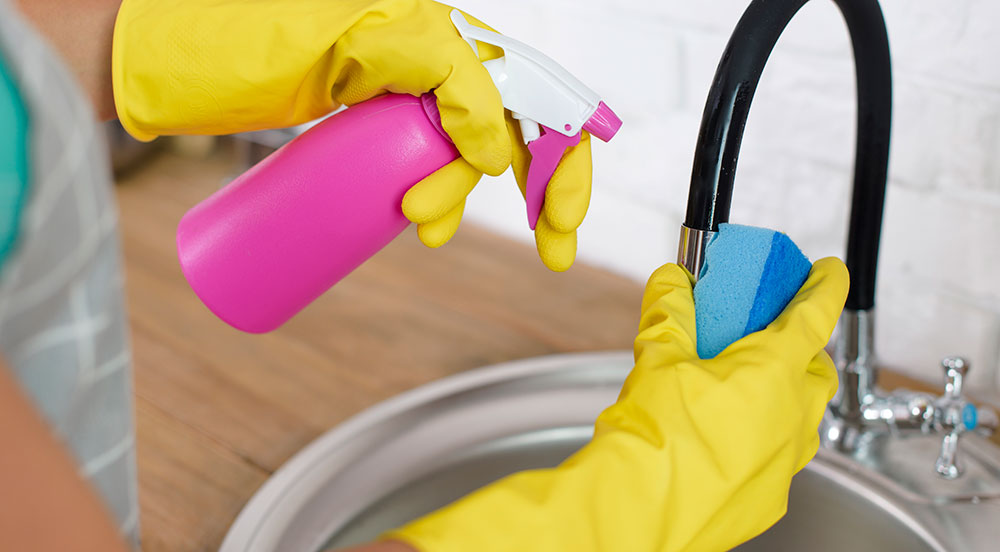Kitchen Sink

Disinfecting and Keeping Your Kitchen Sink Clean
The sink is often seen as a symbol of cleanliness. After all, this is where you do most of your washing and cleaning jobs. Look around all kitchen sinks, and you will most likely find cleaning clips like soap, sponges, towels, and brushes. With that in mind, you’d be surprised to find that the kitchen sink is usually one of the dirtiest things in some homes.
The combination of water, leftover food, and other wastes create an important breeding ground for pathogenic bacteria. For this reason, you must know how to clean the kitchen sink. Please follow the steps below that describe exactly how to keep your kitchen sink clean.
We will focus on cleaning ceramic sinks, and stainless steel sinks as these are some of the most common kitchen sink types.
How to clean the sink without harsh chemicals
When cleaning the interior of the house, you might not want to use chemical cleaners. Chemical cleaners can produce a strong odor and cause headaches and eye irritation. You will notice these chemical cleaners are hazardous if ingested. Chemical cleaners can be very risky, especially if you have children or pets.
For these reasons, natural cleaning alternatives have become very popular. They are much less risky to use, can be used in homes, and are very effective at cleaning up. The following explains how to clean the sink without using harsh chemicals. These methods are very effective and can be used to clean ceramic and stainless steel sinks.
White vinegar
Without mentioning white vinegar, the guide to cleaning the kitchen sink is incomplete. White vinegar is very good for treating grease, bacteria, and quicklime.
If you want to sanitize the kitchen sink, vinegar is the best solution too. White vinegar can kill bacteria without any risks similar to chemical cleaners.
To clean the sink with vinegar, mix a solution of equal parts vinegar and water in a spray bottle. Because of the versatility of vinegar as a cleaning agent, it’s a good idea always to have a spray bottle handy. After you’ve rinsed the sink to remove any residue, spray the sink with the vinegar solution and wipe it dry.
Don’t forget your tap! Vinegar can break down the lime that can settle around the spout well. To remove lime buildup, dampen a cloth with vinegar and warm water to wipe the faucet clean.
If you are feeling adventurous, scrub the sink with baking soda before spraying vinegar. Then add vinegar and watch for the foam reaction between baking soda and vinegar. Let the carbonated solution sit for a few minutes, then rinse and dry it.
Clean with lemon
Another popular alternative to natural cleaning is cleaning with lemon. The process is very simple. Just take a lemon, cut it in half or into smaller pieces, and scrub the sink with the chopped pieces. Add more salt for more help. Its roughness makes it possible to remove difficult-to-remove particles that stick to the sink. When you’re satisfied, rinse and dry the sink.

Disinfect the sink with bleach
Warning: Do not use bleach in the stainless steel sink. Bleach can attack steel and damage the sink. If you have a ceramic sink, check the pipe under the sink. If you have stainless steel pipes, please do not use bleach.
Vinegar can be a reliable natural disinfectant, but if you’re looking for something a little more powerful, bleach can be the solution. While stainless steel isn’t very safe, bleach can be safe for your ceramic sink.
There are two main methods that you can use to sanitize the sink with bleach. First, you can cap the drain and fill the sink with warm water and add bleach to create a solution. Remember, you need very little bleach to make a disinfectant. Only a quarter of the bleach can be used per gallon of water. Let the solution sit in the sink for a few minutes, then drain and rinse meticulously.
Or you can create a solution in a bucket or bowl and use it to wipe the sink down. When handling bleach, remember to wear gloves to protect your hands. After disinfecting, rinse the sink thoroughly to prevent all of the bleach from washing away.
How to clean the sink drain and garbage disposal
Now, you know that one of the best ways to clean your drain and garbage disposal is to use the old baking soda and vinegar method. Add equal amounts of baking soda and vinegar to the two drain holes in the sink and let the solution do the rest! After a few minutes, use warm water to rinse the sides of the sink.
To get rid of the garbage disposal stink, please put the citrus peel scraps in the landfill and run them with cold water. Some experts recommend freezing your citrus peel to make it easier to crack during disposal.
Maintain the sink in between cleanings.
In between cleanings, you can help keep the sink in good condition by:
- Spray white vinegar on the sink after each use
- Dry the sink after each use
- Do not leave dishes or other objects in the sink for long
With regular maintenance and cleaning, the sink shouldn’t stress you. However, it is almost impossible for all your household devices to be in good use after some years of use. That is why we have come up with this booklet to keep your life and home going.